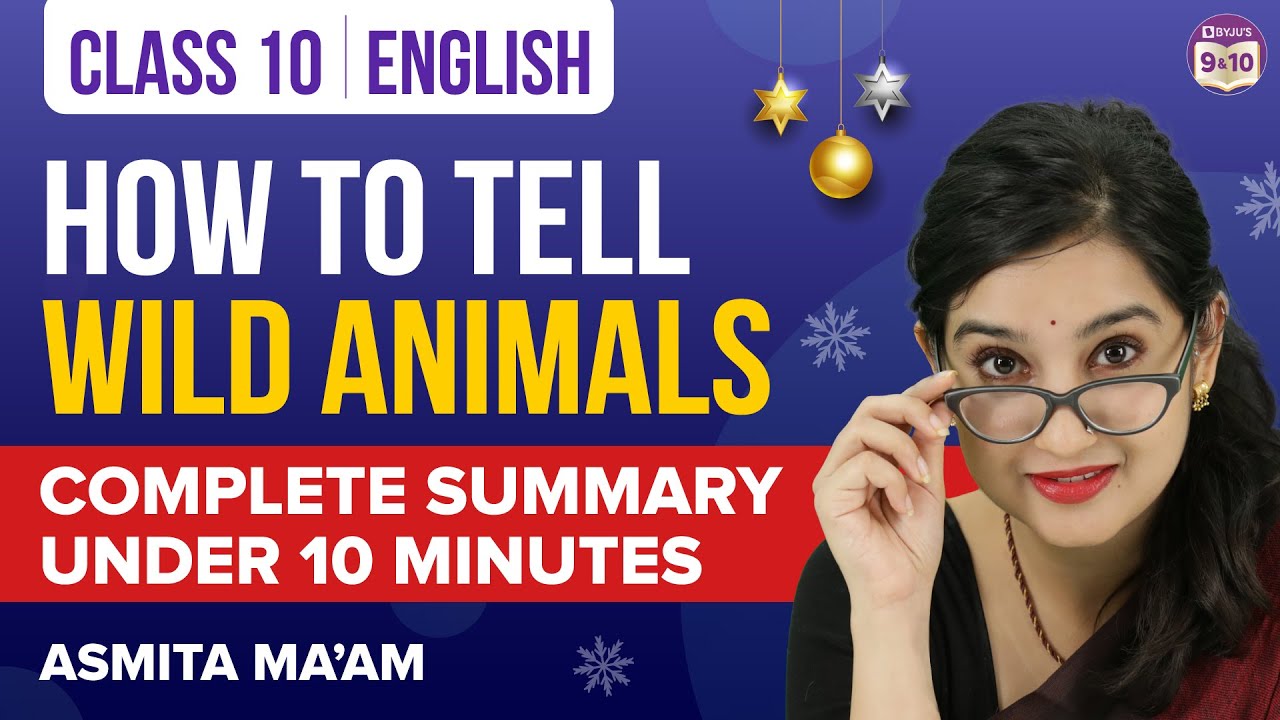Poem: How To Tell Wild Animals | Animation in English | Class 10 | First Flight | CBSE
Summary
TLDRCaroline Wells' poem 'How to Tell Wild Animals' uses humor to identify ferocious creatures. The poem, with its ABABCC rhyme scheme, humorously describes how to spot animals by their attack methods: Asian Lions' terrifying roars, Bengal tigers' deadly stripes, leopards' relentless spots, bear's deadly hugs, crocodiles' deceptive tears, and chameleons' camouflage. Wells' creative and witty approach entertains while educating about wildlife.
Takeaways
- 🐅 The poem humorously describes how to identify wild animals by their lethal features.
- 📖 The poem 'How to Tell Wild Animals' consists of six stanzas with an AB AB CC rhyme scheme.
- 🇦🇸 The Asian Lion can be recognized by its tawny skin and terrifying roar.
- 🐯 The Bengal tiger is identified by its black stripes and deadly predatory nature.
- 🐆 If an animal with spots attacks you, it's likely a leopard, whose attack won't be stopped by screams.
- 🐻 A bear can be recognized by its potentially deadly 'bear hug'.
- 🐊 The difference between a hippo and a crocodile is highlighted by their expressions: hippos smile, while crocodiles have 'tears'.
- 🐊 The phrase 'crocodile tears' is creatively used to illustrate the crocodile's behavior.
- 🦎 Chameleons are likened to lizards and are masters of camouflage, changing color to blend into their surroundings.
- 🎨 The poem uses humor as a literary device to entertain while educating about wild animals.
Q & A
What is the main theme of Caroline Wells' poem 'How to Tell Wild Animals'?
-The main theme of the poem is the humorous identification of various wild animals based on their unique and sometimes lethal characteristics.
What literary device does Caroline Wells use in her poem?
-Caroline Wells uses humor as a literary device to highlight the distinctive features of wild animals.
What is the rhyme scheme of the poem?
-The poem follows an ABABCC rhyme scheme.
How does the poem describe the Asian Lion?
-The poem suggests recognizing the Asian Lion by its tawny skin and the fact that hearing its roar could be so terrifying that one might die of fear.
What is the humorous way the poem describes the Bengal tiger?
-The poem humorously states that if an animal with black stripes notices you and eats you, it must be a Bengal tiger.
How does the poem suggest identifying a leopard?
-The poem indicates that if an animal with spots attacks you and screaming does not deter it, then it is a leopard.
What is the humorous description of a bear in the poem?
-The poem humorously describes a bear as giving such a tight 'bear hug' that it could potentially be fatal.
What question does the poet pose to the reader in stanza 5?
-The poet asks the reader if they know how to recognize beasts that hunt their prey.
How does the poem differentiate between a hyena and a crocodile?
-The poem humorously differentiates hyenas and crocodiles by stating that hyenas always have a merry smile while crocodiles have tears in their eyes, even when they kill.
What is the unique characteristic of chameleons mentioned in the poem?
-The poem mentions that chameleons change their color to blend into their environment, making them hard to see.
How does the poem use humor to describe the way animals attack their prey?
-The poem uses humor to describe the unique and sometimes fatal ways each animal attacks its prey, making the descriptions both informative and entertaining.
Outlines

Cette section est réservée aux utilisateurs payants. Améliorez votre compte pour accéder à cette section.
Améliorer maintenantMindmap

Cette section est réservée aux utilisateurs payants. Améliorez votre compte pour accéder à cette section.
Améliorer maintenantKeywords

Cette section est réservée aux utilisateurs payants. Améliorez votre compte pour accéder à cette section.
Améliorer maintenantHighlights

Cette section est réservée aux utilisateurs payants. Améliorez votre compte pour accéder à cette section.
Améliorer maintenantTranscripts

Cette section est réservée aux utilisateurs payants. Améliorez votre compte pour accéder à cette section.
Améliorer maintenantVoir Plus de Vidéos Connexes

How to Tell Wild Animals Class 10 English Chapter Summary Under 10 Mins | Class 10 Boards 2023

ANTES Y DESPUÉS DE ANIMALES CRECIENDO. INCREÍBLES TRANSFORMACIONES DE ANIMALES

The Final Battle (it’s over)

How do we fix the zoo?

تحدي ماذا يوجد في الصندوق 😵🎁 والعقاب !! ❌ فأر 🐁 شرس داخل ملابسك 😱🔥

ICSE Class 10 English The Power of Music Poem Explanation, Figures of Speech
5.0 / 5 (0 votes)
